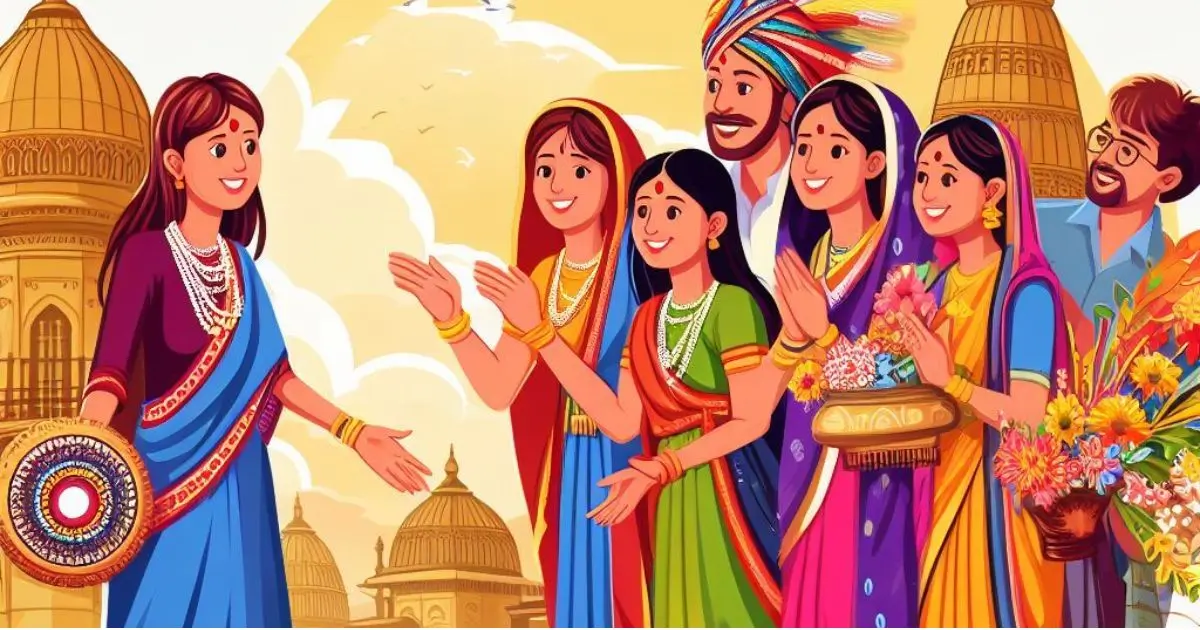In the heart of India, Bihar is a land of rich cultural diversity, exemplified by the varied characteristics of its people. Biharis are known for their simplicity and down-to-earth nature. From the bustling cities to the serene villages, you’ll find people who value relationships, tradition, and the essence of a close-knit community.
The Bihari spirit thrives on the simplicity that binds people together, regardless of their backgrounds. This article covers a detailed journey into the intricate tapestry of Bihar’s population, shedding light on the nuances of their hospitality, the complexity of caste and tribal dynamics, and the distinctive physical features that define them.
Page Index
Hospitality
Bihar is renowned for its hospitality, a cultural trait deeply embedded in the psyche of its people. Whether in urban centers or rural villages, strangers are welcomed with open hearts, and guests are treated with utmost respect.
The hospitality extends beyond individual households to public spaces, creating a sense of communal warmth that defines the social ethos of Bihar.
Self-Respect and Work Ethic
Bihar takes pride in its self-respecting populace, known for their unwavering commitment to hard work. The people, regardless of caste or tribe, approach their occupations with dedication and diligence.
The Bihari spirit is synonymous with hard work and determination. Whether it’s pursuing education, striving for success in the professional arena, or contributing to the agricultural landscape, Biharis embodies a strong work ethic. Their ambitious drive is a testament to their desire for progress and a better future.
This work ethic, deeply rooted in their cultural values, not only sustains livelihoods but also contributes significantly to the economic and social progress of the state.
Cultural Richness
The amalgamation of these diverse elements contributes to the overall cultural richness and harmony that defines Bihar. Despite the apparent differences, the people of Bihar share a common thread of resilience, community spirit, and a deep-rooted connection to their heritage.
Namaskar Bihar! In the heart of India, where the Ganges flows gracefully and history echoes through ancient ruins, lies the vibrant state of Bihar. This land, often called the cradle of civilization, is not just a place on the map; it’s a tapestry woven with threads of culture, history, and progress. In this blog, we’ll take a journey through Bihar, exploring the diverse facets that make it truly unique.
- Rich Cultural Heritage: Bihar is a melting pot of cultures, blending the traditions of Hindu, Buddhist, and Jain philosophies. From the famed Nalanda University, an ancient center of learning, to the sacred Bodh Gaya where Lord Buddha attained enlightenment, Bihar is a repository of spiritual wisdom. The Chhath Puja, a unique festival dedicated to the Sun God, is celebrated with fervor, connecting the people to their roots.
- Historical Marvels: Step back in time as you explore Bihar’s historical marvels. The ruins of Nalanda and Vikramshila universities stand testament to Bihar’s intellectual legacy. Patna, the capital, boasts the Patna Sahib Gurudwara, a significant pilgrimage site for Sikhs. The ancient city of Vaishali, believed to be the world’s first republic, adds another layer to Bihar’s historical narrative.
- Land of Festivals: Bihar is a land of festivities, where every season brings a reason to celebrate. From the lively colors of Holi to the joyous sounds of Durga Puja, the state resonates with the spirit of togetherness. Sonepur Mela, one of Asia’s largest cattle fairs, is a spectacle where traditions merge with commerce, showcasing the vibrant pulse of Bihar.
- Economic Growth and Development: In recent years, Bihar has been on a journey of economic growth and development. The state has witnessed infrastructural advancements, improved education, and a growing IT sector. Initiatives like ‘Badh Chala Bihar,’ ‘Bihar Startup Policy’ and ‘Jal-Jeevan-Hariyali,’ reflect the government’s commitment to propelling the state into a new era of progress, creating opportunities for its people.
- Cuisine that Speaks: Bihari cuisine is a treat for the taste buds, offering a diverse array of flavors. From the iconic litti-chokha to the mouthwatering sattu (roasted gram-flor), Bihar’s culinary delights reflect its agrarian roots. The warmth of hospitality is best experienced through a traditional Bihari meal, where every dish tells a story of the region.
Arts and Crafts
Bihar’s folk arts are a celebration of its diverse communities. Chhau dance, once a war dance, has transformed into a narrative ballet, expressing the creative joy of tribal communities. The Jhijhiya and Jat-Jatin dance of the Mithila region, performed by Harijans, unfolds a captivating story as dancers adorned with masks depict the journey of a husband and wife.
Bidesia, a dance drama, captivates audiences in the Bhojpuri-speaking regions. The melodious tunes of Vidyapati’s songs still grace the evenings in Mithilanchal. These tunes, rooted in the early medieval age, add a lyrical touch to the region, while Bhojpuri folksongs set the stage on fire with their beats and rhythm. Bihar’s handicrafts are a testament to its skilled artisans.
From bamboo articles to leather works, statues made of white metal to wooden toys, and baskets woven from cane and bamboo – each creation reflects the artistry of the villages around Bodhgaya. Bhagalpur, renowned for its silk industry, produces the distinct tussah or tusser silk, coveted for its quality.
Sujni embroidery, lac bangle making, and the creation of decorative and utility items from Seenki, a local dried grass, further contribute to Bihar’s rich craft traditions.
Caste Dynamics
Bihar’s social fabric is woven with different castes, each contributing to the state’s cultural milieu. Among the non-tribal communities in the north, one encounters a spectrum of castes such as Kayasthas, Bhumihars, Rajputs, and several backward castes like Yadavs, Koeris, Musahars, and Chamars.
The latter, often marginalized, play a crucial role in shaping Bihar’s social landscape. Meanwhile, in the southern regions, aboriginal tribes like Santhals, Mundas, and Oraons add a layer of cultural diversity, maintaining their distinct tribal identities.
Tribal and Non-Tribal Distinctions
Beyond caste divisions, a notable aspect of Bihar’s demographics lies in the physical distinctions between the non-tribals of the north and the tribal communities of the south.
The former often possess smoother features and a relatively fairer complexion, while the latter exhibit negroid features and are characterized by a shorter stature. These distinctions reflect not only the geographical diversity but also the historical and cultural influences that have shaped Bihar over the centuries.
In conclusion, Bihar’s people represent a captivating blend of diversity, characterized by their warm hospitality, distinct caste dynamics, and the coexistence of tribal and non-tribal communities.
This detailed exploration serves as a testament to the intricacies that shape the cultural mosaic of Bihar, making it a fascinating and unique tapestry within the vibrant fabric of India.


